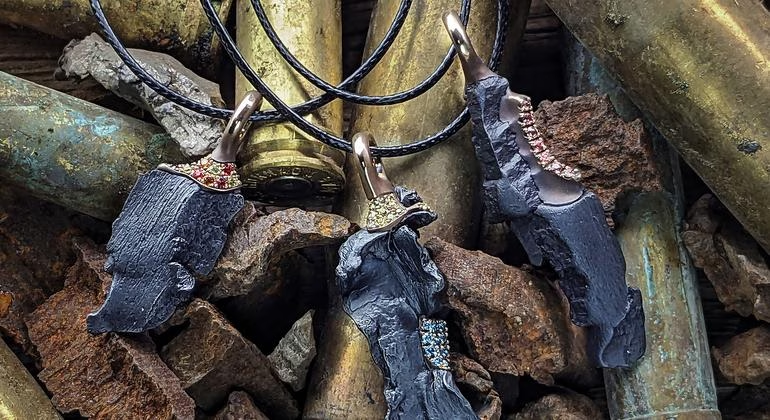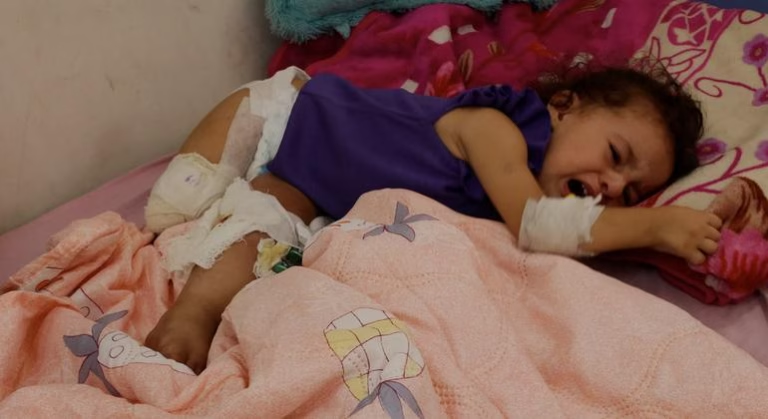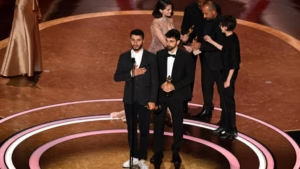On the occasion of International Mine Awareness Day, observed annually on 4 April, ongoing initiatives are cautiously removing and safely disposing of the unexploded weapons left on battlefields. Meanwhile, artists like Mr. Drokin are transforming these fragments of war into unique jewelry, ornaments, and sculptures.
There is no shortage of material for designers to work with.
Turning Trench Artifacts into Trinkets
Currently, tens of millions of these deadly devices remain scattered across former battle zones worldwide, long after the conflicts have evaporated.
Laos and Ukraine have some of the highest concentrations of unexploded ordnance. In Laos alone, only one percent of the approximately 80 million now-banned cluster bombs released during the Vietnam War over half a century ago have been safely deactivated and removed.
Unexploded ordnance continues to claim lives globally, despite the ongoing efforts of mine action history, demonstrating hard-won progress, according to UNMAS, the UN entity that conducts demining activities, from Gaza to Ukraine.
In Ukraine, Mr. Drokin’s studio is both his workshop and living space. Here, the renowned artist and university lecturer narrates the story of war using shrapnel pieces brought to him by friends, colleagues, volunteers, and military personnel subsequent to Russia’s full-scale invasion in February 2022.
“In the early days of the war, my art workshop became a temporary warehouse for volunteers of the Kharkiv military hospital,” Mr. Drokin said.

A warning sign about landmines in Ukraine.
Mobile Testimonies of War-torn Ukraine
Contemplating how he could aid Ukrainians when his city on the frontline was under continuous artillery fire, Mr. Drokin commenced work on the first of several collections in early May 2022.
Since then, he has launched the Forget-me-not sculpture project, molded from shell fragments and styled titanium flowers, with one piece selling for over $14,000 at Sotheby’s in Geneva, proceeds of which went to Lviv-based Superhumans, a center assisting war-affected individuals.
Following this, he unveiled the Revival collection, inspired by a contact with Elizabeth Suda, founder of Article 22, a New York startup that sells bomb remnant-based pieces and supports demining in contaminated territories.
“Pieces from the collection are meant to uphold the memory of the tragedies, destruction, and sorrow that wars inflict upon humanity,” Mr. Drokin stated.
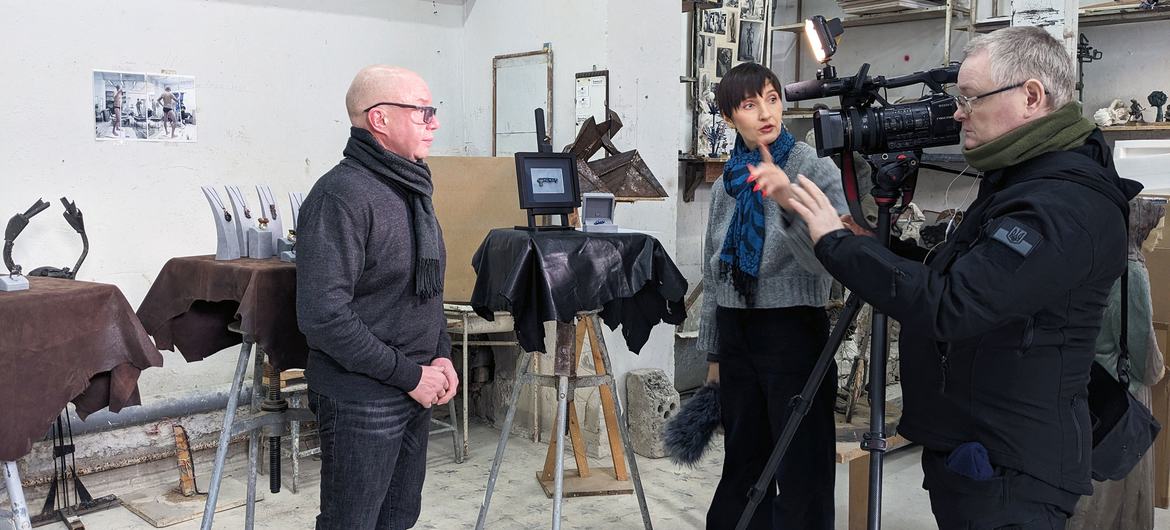
Designer Stanislav Drokin is interviewed by a local news team in Kharkiv, Ukraine.
‘Each Piece Has a Story’
At the Pen and Brush Gallery in New York’s trendy Flat Iron neighborhood, bracelets fashioned from cluster bombs dangle on the arms of Kendall Silwonuk, who is setting up a pop-up with an assortment of Mr. Dorkin’s necklaces and other Article 22 items.
“Each piece holds a narrative,” Ms. Silwonuk shared.
Displaying a weighty wooden block used by Laotian artisans to create bracelets, she elucidated the process. Artisans collect aluminum bomb casings from demining efforts, melt them down, and cast the molten material into mold cavities within heavy wooden blocks. Once set, out comes a bracelet.
She noted that Article 22 supports initiatives aimed at rebuilding lives, including via the US-based Legacy of War Foundation, established by photojournalist Giles Duley, a triple amputee following a 2011 improvised explosive device injury in Afghanistan and the first UN Global Advocate for persons with disabilities in conflict and peacebuilding situations.

Kendall Silwonuk at an Article 22 pop-up shop in New York showcasing jewelry crafted from war remains.
‘Conscious Consumerism’
In Laos, Article 22’s Elizabeth Suda encountered artisans crafting spoons from cluster bomb debris in the early 2000s and was determined to bring their skills and story to a broader audience.
The company’s name draws from the Universal Declaration of Human Rights, where Article 22 asserts that “everyone, as a member of society, has the right to social security and is entitled to the realization, through national effort and international cooperation and in accordance with the organization and resources of each State, of the economic, social and cultural rights indispensable for his dignity and the free development of his personality.”
“This is a humanitarian issue the public can engage with by being aware and supporting organizations that clear unexploded bombs from the land, as well as any organization or business undertaking this through conscious consumerism,” she explained.
For Laotian artisans working with Article 22, this collaboration means increased income and cleared minefields, now converted into rice paddies.

A local rice farmer in Laos.
Merging Chaos and Harmony
Back in Kharkiv, Mr. Drokin is sketching fresh designs, utilizing precious colored stones and diamonds to “combine them with shrapnel fragments produced by the chaotic energy of explosions” for his growing audience. This clientele includes presidents, volunteers, journalists, mayors, doctors, philanthropists, and military heroes, with select pieces finding their way into private collections and museums from the National History Museum of Ukraine to the White House’s East Wing.
“I enjoy combining harmony with chaos, leveraging the emotions of color and its combination, and spotlighting the images and shapes shaped by man and nature,” he said. “As a lecturer, I wish to impart knowledge and accumulated experience to students, instilling in them a sense of responsibility, harmony, and peace for the younger generation.”
Does he have a favorite piece?
“It will be the last piece I create once the war concludes, when the much- awaited and just peace arrives, people stop perishing, and the contaminated lands of Ukraine are cleared of unexploded mines, rockets, and shells,” Mr. Drokin maintained.
While certain artisans in Laos and Ukraine continue to engage in a lively trade, the practice of salvaging and transforming war remnants into wearable art is catching on around the globe.
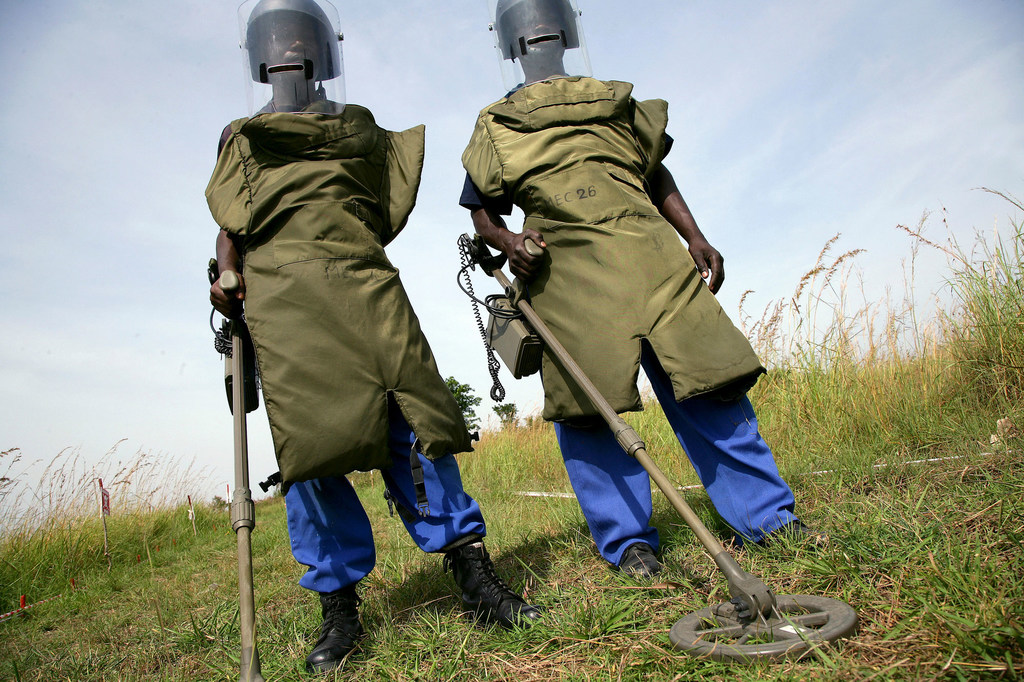
Among these are:
- In Colombia, even prior to the conclusion of their decades-long war, jewelry designers created collections from bullet casings, and some continue today.
- In Cambodia, remnants from half-century-old brass bombshells are being repurposed by an association into jewelry, promoting peace.
- In the Democratic Republic of the Congo (DRC), retrieved bullet casings and AK47 machine guns are incorporated into wristwatches and wedding rings.
- In Israel and Palestine, some among the tens of thousands of fallen bombs and rockets now serve as mezuzahs, statues, necklaces, and amulets.
Source: https://news.un.org/feed/view/en/story/2025/04/1161391



